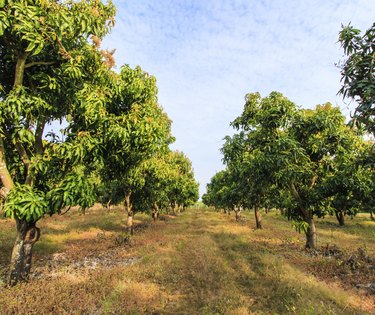A home orchardist planting mango trees (Mangifera indica) in anticipation of a months-long annual harvest of smooth-skinned, sweetly succulent fruit faces many obstacles. Not the least is that mangoes, suitable only for the balmy climates of U.S. Department of Agriculture plant hardiness zones 11 though 12, must flower to bear fruit. The catch is that they typically bloom only in alternate years. Intervention through the application of potassium nitrate, however, stimulates them to blossom annually. Credit for this discovery goes to Filipino horticulturalist Dr. Ramon Barba, who perfected the technique in the 1970s, notes the World Intellectual Property Organization.

Video of the Day
Things You'll Need
Sprayer With Agitator
13-0-46 Potassium Nitrate Powder
Protective Clothing, Including Gloves And Eyewear
Ladder (Optional)
Step 1
Treat dry trees when no rain is expected for at least six hours after you finish. Apply the potassium nitrate solution during cloudy weather; if that's not possible, treat the trees before 9 a.m. or between 4 and 5 p.m. Direct sun may burn mango foliage sprayed with potassium nitrate.
Video of the Day
Step 2
Use a potassium nitrate solution of the appropriate strength. A low-dosage, 1 to 2.5 percent solution is suitable for healthy, large mature mango trees with mature leaves and buds. Apply it from seven to nine months after the last harvest. For younger trees with leaves and buds just beginning to mature, or mature trees harvested within the past six to seven months, use a 3 to 4 percent solution. To determine how much powder you need, multiply 128 -- the number of ounces in 1 gallon -- by the appropriate percentage. A 2.5 percent solution requires about 3.2 ounces, or 6.4 tablespoons, of potassium nitrate per gallon of water.
Step 3
Fill your spray tank with enough water to treat your mango trees. Add 1/4 to 1/2 ounce -- or the manufacturer's recommended amount -- of a spreading-sticking agent per 10 gallons of water and agitate it thoroughly. Follow with the suitable amount of potassium nitrate powder and agitate again.
Step 4
Spray each tree until all the solution coats its branches and leaves thoroughly, but not heavily enough to drip. Agitate the mixture frequently so the sticker and powder remain dispersed. If a tree is too large for you to reach all its branches, access the canopy with a ladder supported against its trunk. Carefully spray the uppermost branches first and work your way down, making sure to coat each area well before moving to the next.
Step 5
Watch the trees for flower buds, which should appear after 10 days to two weeks. Protect the unfurling flowers against insect or fungal attacks, if necessary, by spraying with ready-to use organic neem oil. At the first sign of a problem, coat all plant surfaces until they drip. Repeat the application every one to two weeks until the pests or the disease-favoring conditions have subsided.
Tip
Calcium nitrate, containing 45 percent calcium and 15 percent nitrogen, is an effective and affordable alternative to potassium nitrate.
Warning
Don't use this technique to induce flowering in any tree that failed to put out a new flush of growth following the previous year's harvest.
If a sprayed mango tree doesn't produce buds within two weeks, don't respray it. It's simply not ready to flower.
Potassium nitrate powder and neem oil may irritate the skin, eyes and respiratory tissues. When handling them, always wear protective clothing, including a long-sleeved shirt, long pants, gloves, respiratory mask and eye-wear. Wash your clothes and shower immediately after spraying the trees.
- Cal Poly San Luis Obispo Urban Forest Ecosystems Institute: Mango (Mangifera Indica)
- California Rare Fruit Growers: Mango
- World Intellectual Property Organization: The Scientist, the Patent and the Mangoes -– Tripling the Mango Yield in the Philippines
- The Philippine Star: Too Much Flower Inducer Spraying Bad for Mangoes
- Philippines Bureau of Agricultural Research: Mangoes
- AgriBusiness Week: Pointers on Applying Flower Inducer to Mango Trees
- World Agroforestry Center: Flower Induction
- University of Hawaii College of Tropical Agriculture and Human Resources: Mango Anthracnose (Colletotrichum Gloeosporiodes)
- University of Hawaii College of Agriculture and Human Resources: Growing Mangoes in Hawaii: A Small Orchard Grower's Perspective